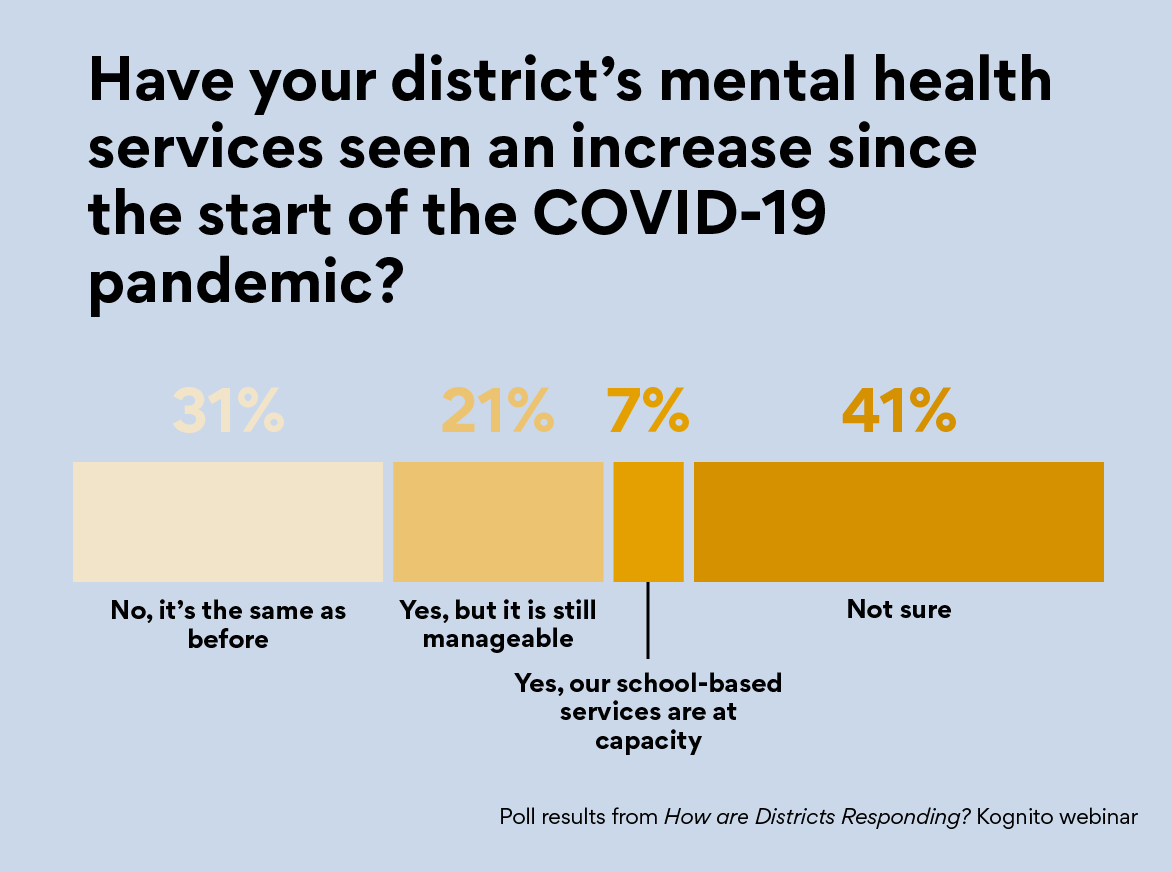Adapting Your School Mental Health Services During COVID-19 Closures
Schools have acted quickly to put remote learning structures in place in response to COVID-19 closures. As school communities settle into this “new normal,” district leaders and school mental health services turn their attention toward the next area of focus: student mental health.
According to a poll we conducted with participants in our COVID-19 and School Mental Health webinars, most district leaders report their demand for school mental health services is either the same as before, or increased but “still manageable” … for now. That could quickly change, and districts should be prepared to flatten the next curve: student mental health.

Here’s a closer look at how the pandemic is affecting student mental health, and what districts can do now to prepare faculty, staff, and school mental health services to support students’ needs.
How COVID-19 is Affecting Student Mental Health
For many students, school is more than a place of learning; it’s a place of stability and refuge. If their home life is unstable, school is a place of routine and structure. Some rely on free and reduced lunch programs for food. Many depend on school mental health services for support. So what happens when these students are suddenly removed from this support system?
More research is needed to uncover the impact this crisis is having on the younger population. In the U.K., YoungMinds surveyed over 2,000 students with a history of mental illness to gauge the current climate. The response was dismal but not surprising: 83% said the pandemic had made their conditions worse, and 26% said they were unable to access mental health support. The most common concerns they cited about coping over the next few months included:
- Isolation/loneliness
- Not having enough food/supplies
- Managing mental health/mental health deteriorating
Students with special needs—particularly those with autism spectrum disorder—are at particularly high risk as disruption in their daily routines can cause frustration.

It’s clear that these conditions of the pandemic are a recipe for another outbreak of sorts: a mental health crisis.
What Can Be Done Now to Prepare Staff & School Mental Health Services
Now that virtual learning systems and processes are being set up or are in use, we are in the quiet before the next storm. It’s time to turn attention to preparing educators and school mental health services.
Here are a few things that can be done now to create a culture of caring that is better equipped to support students’ mental health needs during this crisis.
Prepare all teachers and staff to address mental health
School mental health services will be vital during this time, but they need support from every educator who is on the frontlines working with students. Remote learning that promotes student wellbeing requires teachers to have the knowledge and skills to:
- recognize an at-risk student,
- address the concern with the student,
- and connect them to support services if needed.
Educators can also implement trauma-informed practices in the classroom. This approach was already gaining popularity throughout the country, but as we face this collective trauma, it’s now even more important.
Ensure all educators have the knowledge and skills needed to help students at this time. If there’s a knowledge gap that needs to be filled, invest in online professional development so your teachers are better prepared to support student mental health.
Prioritize social-emotional needs of students and staff
Addressing students’ needs from both a social-emotional learning competency perspective as well as from a mental health perspective is vital. SEL gives students skills in self-management, self-awareness, decision-making, and relationship-building. These building blocks can build a strong foundation for students, but mental health conditions such as anxiety, depression, and mood disorders require special attention. The two initiatives work together in a whole-child approach that aims to provide every student with the support they need.
This goes not only for students but also for teachers, administrators, and school staff. Change and stress, of course, affects adults as well, and schools can serve as a supportive community for their staff. When teachers’ social-emotional needs are met, they are more likely to create a positive and supportive learning environment for students.
Strengthen connections to school mental health services
Although only 16% of students receive mental health services, 70-80% receive that care in a school setting. And that 16% does not reflect the need. Prior to COVID-19, it was reported that only one-fourth of students in need of mental health care receive services.
Existing school mental health services should be bolstered right now wherever possible. If demand for services has not changed yet, it may be evolving soon. It is possible that many students and their parents are seeking help for the first time, or starting to think about where to access services.
To keep up with demand, face-to-face counseling can shift to virtual sessions where possible. Students, staff, and parents likely need reoriented as to how to access these resources. If your schools don’t provide mental health care, inform and refresh students and employees on community resources where they can access support.
The COVID-19 crisis will be one of the formative experiences of younger generations’ lives, and students are already experiencing its damaging mental health effects. School systems do not have the power to erase a pandemic, but they can work now to prioritize mental health and provide much-needed support and resources to help students cope.